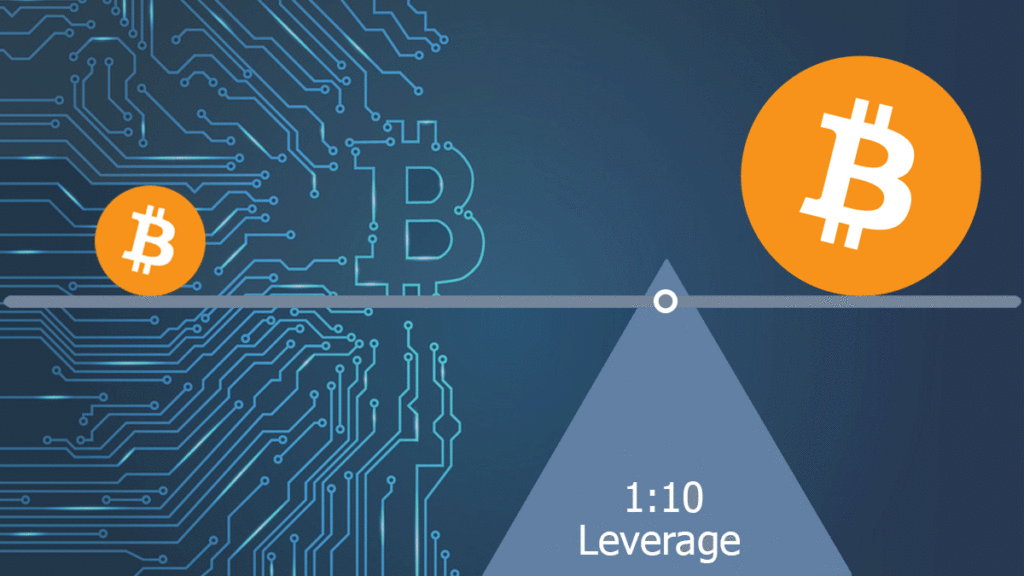Leverage in cryptocurrency trading enables you to gain significant market exposure with a relatively small initial capital outlay. By using borrowed funds to augment your trading position, you effectively increase the potential return on your invested capital.
With the application of leverage, an otherwise modest investment can hold a position much larger than the actual amount of funds you contribute, termed ‘margin’.
Margin trading is essentially the practice of trading assets using funds provided by a third party. In crypto markets, traders employ margin to increase their purchasing power, which allows for greater flexibility in trading strategies without requiring the full value of the holding upfront.
However, with this amplified potential for gains comes a proportional increase in exposure to risk, necessitating rigorous risk management to safeguard your investments.
Different markets offer varying degrees of leverage, with crypto futures trading sometimes allowing for leverage ratios significantly higher than those in traditional markets.
While leverage can be an attractive tool for maximizing the impact of your investment decisions, it’s imperative to understand the risks associated with these trading instruments, including the possibility of rapidly incurring losses that exceed your initial margin.
Intelligent use of leverage is therefore contingent upon a thorough grasp of both market movements and the leveraged products themselves.
Margin Requirements

When you trade crypto futures, the exchange sets specific margin requirements that dictate the minimum amount of capital you must hold to open and maintain positions. These requirements are in place to ensure that there is enough collateral to cover potential losses.
Initial Margin
The Initial Margin is the percentage of a position’s value that you must deposit to start a futures contract. This deposit acts as collateral and is a portion of your total buying power.
To control larger positions, only a fraction of the total value is required upfront, which is the leverage ratio. The amount required varies by exchange and is typically set by regulations.
For instance, if an exchange has a leverage ratio of 10:1, and you wish to control a position worth $10,000, your initial margin requirement would be $1,000.
Maintenance Margin
The Maintenance Margin is the minimum equity you need to maintain your open positions. If your account balance falls below this threshold, known as the maintenance margin requirement, you’ll receive a margin call.
This is a demand from your broker to deposit additional funds or securities to bring your account balance up to the required maintenance level.
It’s crucial to monitor your equity to prevent a margin call, as failing to meet the maintenance margin can result in the liquidation of your positions to cover the shortfall.
Margin Call
In the realm of crypto futures trading, a margin call is a critical event that requires your immediate attention. This occurs when the value of your account balance falls below the required maintenance margin, which is the minimum amount of equity you must hold to keep your trading positions open.
When trading on margin, you are borrowing funds to increase your buying power, which magnifies both potential gains and potential losses.
As the market fluctuates, so does the value of the collateral that supports your leveraged positions. If the market moves against you and your losses approach the initial margin you’ve supplied, your broker will issue a margin call.
This is to ensure that there is enough capital in the account to cover the potential losses and to keep the market functioning smoothly.
Actions to Take During a Margin Call:
- Deposit Funds: Add capital to your account to meet the maintenance margin requirements.
- Close Positions: Voluntarily liquidate your positions to reduce your leverage and restore your account balance.
Risk Management Strategies:
- Set Stop-Loss Orders: Automatically close positions at a predetermined price to manage potential losses.
- Monitor Actively: Regularly check your positions and account balance to anticipate and avoid margin calls.
Liquidation

In the high-stakes environment of crypto futures trading, liquidation is a critical term you must understand. Liquidation occurs when your position is automatically closed by the exchange because your margin account cannot sustain the required minimum balance to keep the trade open.
This happens when the market moves against your position—be it long or short—eroding your capital to a level that no longer covers the leverage used.
To manage risks, you should always be aware of the balance in your margin account. In a long position, where you’re betting on the price increase of a cryptocurrency, a significant drop in price can trigger liquidation.
Conversely, a short position—anticipating a price decline—becomes at risk if the price climbs too high. The leverage you employ amplifies both your potential gains and your potential losses.
Here’s how you can be impacted by liquidation:
- Using Higher Leverage: The greater the leverage, the smaller the price movement needed to trigger liquidation.
- Maintenance Margin: This is the minimal amount of equity you need to maintain a leveraged position. If your balance falls below this, prepare for liquidation.
To protect yourself, implementing a stop loss is a valuable strategy. This tool automatically exits your trade at a predetermined price, thereby limiting your losses.
Here is a simple yet effective way to leverage its benefits:
- Set a stop loss slightly below the purchase price for a long position, or above the selling price for a short position.
- Use a liquidation calculator to assess risks associated with differing levels of leverage.
- Regularly monitor and adjust your stop loss in response to market movements and price volatility.
Leverage and Trading
When engaging in cryptocurrency futures trading, you’re essentially entering a realm where positions are greatly magnified beyond the initial investment, thanks to leverage. This section will focus on the mechanisms of leverage in crypto trading and the essential practices to manage its associated risks.
Leverage in Crypto Trading

Leverage in crypto trading enables you to control a large position with a relatively small amount of capital. It’s akin to a force multiplier, enhancing your potential gains from small price movements.
Crypto exchanges, like Bybit, offer leverage ratios for trading instruments, such as Bitcoin futures.
For example, a 10:1 leverage ratio means you can open a position worth ten times your initial margin. However, while leverage magnifies returns on successful trades, it equally inflates losses, which can exceed your initial investment.
Key Points with Leverage:
- Leveraged Funds: Your trading power is increased with borrowed funds.
- Futures Contract: A legally binding agreement to buy or sell the underlying crypto at a future date or price.
- Benefits: Potential for significant gains.
- Disadvantages: Heightened risk, leading to potential substantial losses.
Managing Leverage Risks
Engaging in leverage trading comes with a high risk. The volatility of crypto markets can turn even a slight price movement into a significant gain or loss.
Therefore, it’s critical to implement risk management techniques. Using a stop-loss order is a prudent tactic; it automatically closes your position at a preset price to prevent further losses.
Continuously monitor your leverage ratio and be wary of using the maximum offered leverage. Adequate risk management and an awareness of your leverage ratio can help mitigate the inherent risks of leverage trading.
Trading Futures and Options With Leverage
When you trade cryptocurrency futures and options with leverage, you’re essentially using borrowed capital to increase your trading position beyond what would be available from your cash balance alone. This strategic use of leverage can amplify profits if the market moves in your favor.
Futures Contracts: These are agreements to buy or sell an asset, such as cryptocurrency, at a predetermined price at a specified time in the future. When trading futures, you don’t own the underlying asset; instead, you’re speculating on its future price.
Options: Unlike futures, options give you the right, but not the obligation, to buy or sell an asset at an agreed-upon price before the option expires.
Trading Account: In order to trade with leverage, your trading account must be set up with a platform that provides leveraged trading. It’s important to carefully manage your account to avoid liquidation.
- Initial Margin: This is the percentage of the position’s full value that you must deposit to open a leveraged trade.
- Derivatives: Futures and options are types of derivatives, as their value is derived from the performance of the underlying asset, such as a cryptocurrency.
Frequently Asked Questions
In this section, you’ll find concise answers to common questions about leverage and margin in crypto futures trading, which will better equip you to utilize such financial tools effectively.
How does using leverage affect profit and loss in crypto futures trading?
Using leverage in crypto futures trading amplifies your potential profits or losses in proportion to the degree of leverage you apply. If the market moves in your favor, your gains are multiplied, but the same is true for losses should the market move against you.
How do margin requirements work in cryptocurrency futures markets?
Margin requirements in cryptocurrency futures markets are set by exchanges and determine the amount of capital you must commit to initiate and maintain a leveraged position. The requirements consist of an Initial Margin to open a position and a Maintenance Margin to keep it open, ensuring you have sufficient equity to cover potential losses.
What should traders consider when choosing a leverage ratio for crypto futures?
When choosing a leverage ratio for crypto futures, you should assess your risk tolerance, trading experience, and the volatility of the cryptocurrency involved. Higher leverage can lead to significant gains but also substantial losses, especially when the market is volatile.
Can you explain the process of a margin call in crypto futures trading?
A margin call occurs when the value of your account falls below the exchange’s Maintenance Margin requirement. At that point, you are required to deposit additional funds to maintain your position. If you fail to meet the margin call, the exchange may liquidate your position to cover the shortfall.
Conclusion
In the world of cryptocurrency futures trading, understanding leverage and margin is vital.
Leverage enables you to amplify your trading power, while margin serves as the collateral you must commit.
Remember that leverage is calculated as 1/Margin, so if the margin is 0.04 (or 4%), your leverage would be 25x.
Here are the key points to remember:
- Initial Margin: This is the amount required to open a position on a futures contract. Think of it as an upfront investment.
- Maintenance Margin: The minimum balance you need to maintain your position. Falling below this can lead to liquidation.
Leverage can lead to high profits but, importantly, it also comes with high risk. Potential losses can exceed your initial investment.
To begin margin trading on platforms like Binance Margin, you must deposit assets as collateral.
When engaging with leverage, perform diligent risk management to mitigate potential losses.
Start with cautious steps, and don’t hesitate to use professional tools and advice.
In summary, leverage magnifies your trading capacity in crypto futures trading, while margin is the security you provide.
Use these financial tools with care, and always be aware of the associated costs, such as trading fees and interest on borrowed funds.
